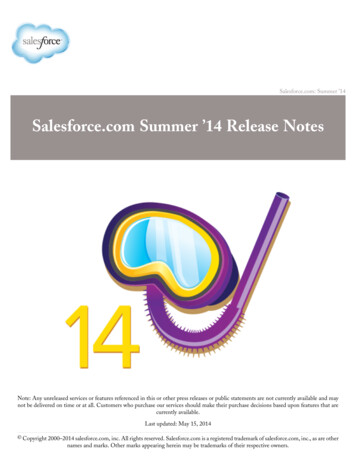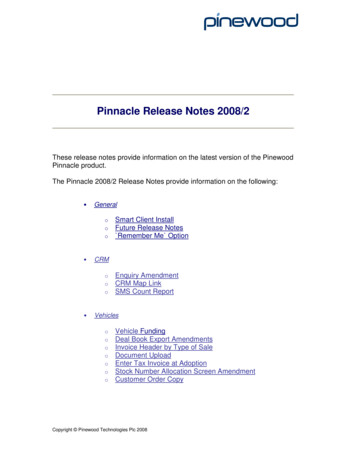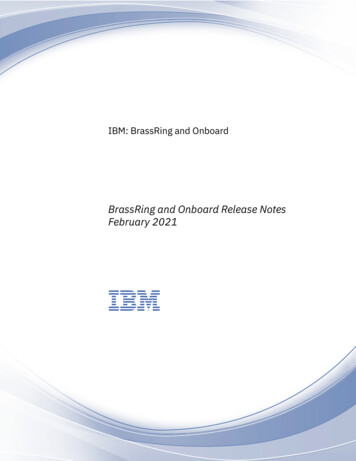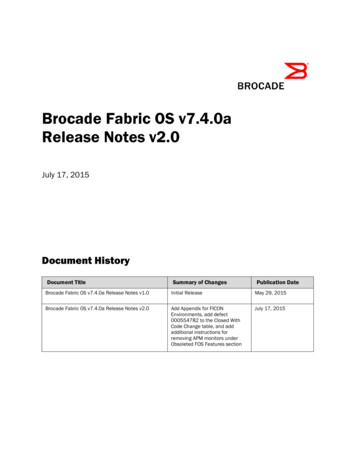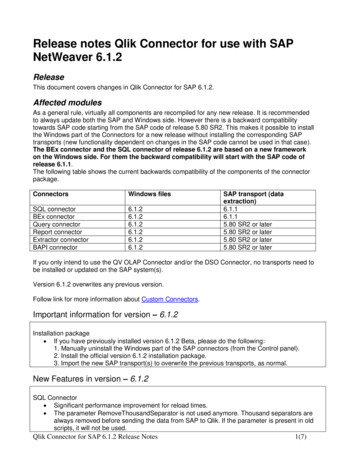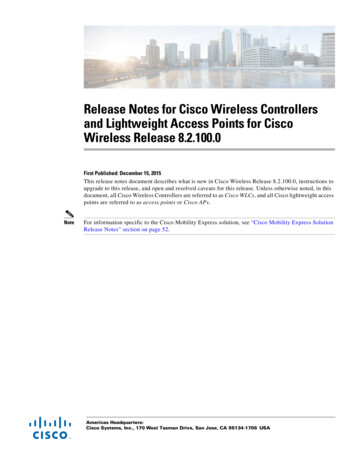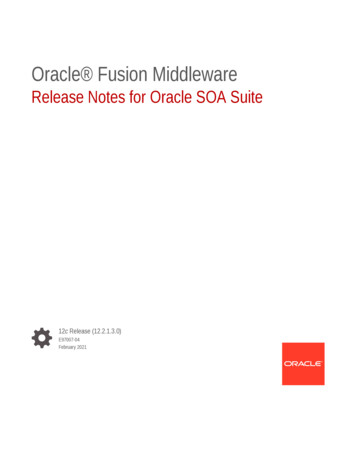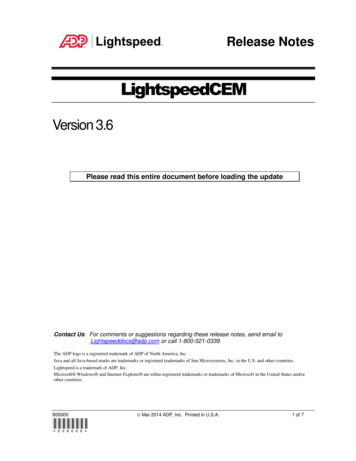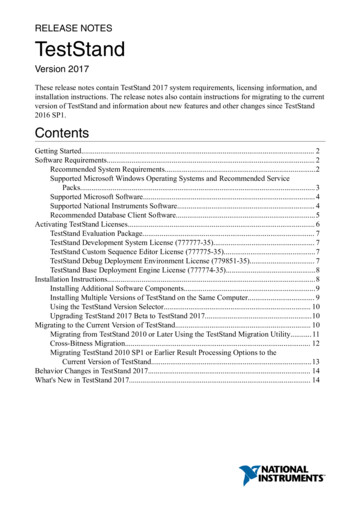
Transcription
RELEASE NOTESTestStandVersion 2017These release notes contain TestStand 2017 system requirements, licensing information, andinstallation instructions. The release notes also contain instructions for migrating to the currentversion of TestStand and information about new features and other changes since TestStand2016 SP1.ContentsGetting Started. 2Software Requirements. 2Recommended System Requirements.2Supported Microsoft Windows Operating Systems and Recommended ServicePacks. 3Supported Microsoft Software. 4Supported National Instruments Software. 4Recommended Database Client Software.5Activating TestStand Licenses. 6TestStand Evaluation Package. 7TestStand Development System License (777777-35). 7TestStand Custom Sequence Editor License (777775-35).7TestStand Debug Deployment Environment License (779851-35). 7TestStand Base Deployment Engine License (777774-35).8Installation Instructions.8Installing Additional Software Components.9Installing Multiple Versions of TestStand on the Same Computer. 9Using the TestStand Version Selector. 10Upgrading TestStand 2017 Beta to TestStand 2017.10Migrating to the Current Version of TestStand. 10Migrating from TestStand 2010 or Later Using the TestStand Migration Utility. 11Cross-Bitness Migration. 12Migrating TestStand 2010 SP1 or Earlier Result Processing Options to theCurrent Version of TestStand.13Behavior Changes in TestStand 2017. 14What's New in TestStand 2017. 14
Getting StartedThe best way to familiarize yourself with TestStand is to explore the Guide to TestStandDocumentation topic in the TestStand Help, which contains links to all the TestStanddocumentation in electronic format. You can access the TestStand Help in the following ways: Select Help»TestStand Help in the TestStand Sequence Editor. (Windows 8.1) Click the NI Launcher tile on the Start screen and select TestStand»Documentation»TestStand Help. (Windows 10 or 7) Select Start»All Programs»National Instruments»TestStand»Documentation»TestStand Help.Software RequirementsRefer to the following sections for information about the software National Instrumentsrequires or supports for use with TestStand 2017.Recommended System RequirementsNational Instruments recommends the system requirements described in the following table torun TestStand 2017.Table 1. Recommended and Minimum System Pentium G1 or equivalentPentium 4/M orequivalentMemory2 GB1 GBDisk space for TestStand (32- or64-bit)1 GB—Disk space for Microsoft .NETFramework version 4.6, if notalready installed2.5 GB—Disk space for device drivers from Amount of space required variesthe National Instruments Devicedepending on the drivers youDrivers DVDinstall. Install only the driversnecessary for the hardware youwill use.Video adapter2 ni.com TestStand Release Notes——1024 x 768resolution
Supported Microsoft Windows Operating Systems andRecommended Service PacksUse the Microsoft Windows operating systems and service packs described in the followingtable with TestStand 2017. You can run 32-bit TestStand 2017 on 32-bit Microsoft Windowsoperating systems or on 64-bit Windows operating systems, as shown in the following table.64-bit TestStand 2017 requires a 64-bit version of Windows 7 or later or Windows Server 2008or later.Table 2. Supported Microsoft Windows Operating SystemsOperatingSystemEditionService Pack(or equivalent)CommentsWindows 10Professional,EnterpriseBuild 1703For more information about NI supportfor Windows 10, visit ni.com/windows10.Windows 8.1Professional,Enterprise—Refer to the How to Use NI Softwarewith Microsoft Windows 8.1 section ofthe TestStand 2017 Readme for moreinformation about using TestStand onWindows 8.1. For more informationabout NI support for Windows 8.1,visit ni.com/windows8.Windows 7Starter,Professional,Enterprise,UltimateSP1Refer to the TestStand and Windows 7/Vista section of the NI TestStandVersion 2012 Release Notes for moreinformation about using TestStand onWindows 7. Visit ni.com/info andenter the Info Code exgmjr to locatethe NI TestStand 2012 Release Notes.WindowsServer 2012(64-bit)EnterpriseR2TestStand supports only R2 editions ofWindows Server.WindowsServer 2008(64-bit)EnterpriseR2Note National Instruments recommends that you install Microsoft Hotfix 2588507for 64-bit Windows operating systems. Visit ni.com/info and enter the Info Codemshotfix for more information about Microsoft Hotfix 2588507.TestStand Release Notes National Instruments 3
Supported Microsoft SoftwareUse the following Microsoft software with TestStand 2017: Microsoft Internet Explorer 11, 10, 9, or 8 Microsoft Visual Studio 2017, 2015, 2013, or 2012 Microsoft .NET Framework 4.6.2TestStand includes features that automate Visual Studio for debugging, generating, and editingcode module source code. Visual Studio Express Editions do not support these features.The .NET and Microsoft Foundation Class (MFC) examples include projects and solutionscreated in Visual Studio 2012.Supported National Instruments SoftwareUse the National Instruments application development environments (ADEs) described in thefollowing tables with 32-bit TestStand and 64-bit TestStand:Table 3. Supported National Instruments Software for 32-bit TestStand 2017SoftwareSupportedLabVIEW (32- and 2017 SP1, 2016,64-bit)2015 SP1, 2014SP1, 2013 SP1Allowed but notSupported2017, 2015,2014, 2013,2012 SP1, 2011SP1CommentsLabVIEW examples and userinterfaces use files created withLabVIEW 2014 SP1.TestStand API support files forLabVIEW use files saved withLabVIEW 2012 SP1.TestStand 32-bit supports calling32-bit VIs using LabVIEW 32bit RTE, and 32- and 64-bit VIsusing the LabVIEW ADE.LabWindows /CVI 2017, 2015 SP1,2015, 2013 SP2,2012 SP1NI SwitchExecutive15.1, 3.6, 3.54 ni.com TestStand Release Notes2013 SP1, 2013,2012 and earlierLabWindows /CVI examples,user interfaces, and API use filescreated with LabWindows /CVI 2013 SP2.TestStand 32-bit supports callingonly 32-bit code modules.——
Table 4. Supported National Instruments Software for 64-bit TestStand 2017SoftwareLabVIEW (32- and64-bit)Supported2017 SP1, 2016,2015 SP1, 2014SP1, 2013 SP1Allowed butnot Supported2017, 2015,2014CommentsLabVIEW examples and userinterfaces use files created withLabVIEW 2014 SP1.TestStand API support files forLabVIEW use files saved withLabVIEW 2013 SP1.TestStand 64-bit supports calling64-bit VIs using LabVIEW 64bit RTE, and 32- and 64-bit VIsusing the LabVIEW ADE.LabVIEW NXG(64-bit)2.0LabWindows /CVI 2017, 2015 SP1,2015, 2013 SP2—2013 SP1 andearlier—LabWindows /CVI examples,user interfaces, and API use filescreated with LabWindows /CVI 2013 SP2.TestStand 64-bit supports callingonly 64-bit code modules.NI Switch Executive 15.1——TestStand can execute code modules developed with versions of ADEs other than the listedsupported versions, but National Instruments performs only limited testing with earlierversions of ADEs. TestStand might be able to execute code modules developed with versionsof ADEs later than the listed supported versions, but National Instruments cannot ensuresupport for versions released after TestStand 2017. Visit ni.com/info and enter the InfoCode tslcp for more information about the TestStand life cycle policy.Recommended Database Client SoftwareUse the following recommended database client software with the database componentsincluded with TestStand: Microsoft Access—(32-bit TestStand) Use the Microsoft Jet 4.0 Object Linking andEmbedding Database (OLE DB) Provider. (64-bit TestStand) Use the Microsoft Office12.0 Access Database Engine OLE DB Provider. You can download this provider fromthe Microsoft website at www.microsoft.com.Note You cannot install the Microsoft Office 12.0 Access Database EngineOLE DB Provider with 32-bit Microsoft Office. Visit ni.com/info and enterthe Info Code 64TSaccdb to access the National Instruments support article,TestStand Release Notes National Instruments 5
Using Microsoft Access Databases with 64-bit TestStand, for more informationabout installing this provider.Microsoft SQL Server—Use the SQL Server Native Client 10.0 or later or the MicrosoftOLE DB Provider for SQL Server provider.Oracle—Use the latest Oracle Provider for OLE DB and Oracle Client software.National Instruments recommends Oracle Client 12c Release 1, version 12.1.0.1.0 orlater. You can download the Oracle Provider from the Oracle website atwww.oracle.com. Note National Instruments does not recommend using the Microsoft OLE DBProvider for Oracle because it does not support all the OLE DB featuresTestStand requires.Note Oracle recommends using Oracle Provider 11.1.0.6.0 or later if youwant to read 64-bit integer values stored in NUMBER columns. MySQL—Use the MySQL Open Database Connectivity (ODBC) Driver 5.1 or later.Sybase SQL Anywhere—Use the Adaptive Server Anywhere ODBC Driver 10.0 orlater.Activating TestStand LicensesAfter you install TestStand, you must use the NI Activation Wizard to activate the software orinitiate the evaluation period for the software.National Instruments offers a variety of licenses for the different ways you can use TestStandin development and deployment applications. You can select from the following types oflicenses: TestStand Development System License TestStand Custom Sequence Editor License TestStand Debug Deployment Environment License TestStand Base Deployment Engine LicenseIn most cases, when you first install TestStand, you activate a TestStand Development SystemLicense. Use the other licenses to activate TestStand on computers to which you deployTestStand custom sequence editors or user interfaces you develop.Contact a local National Instruments representative for more information or for questionsabout specific licensing needs.Note If you upgrade TestStand with a service pack release by installing TestStandor a deployment that includes the TestStand Engine, the TestStand Engine on thecomputer becomes unlicensed. You must reactivate the license on the computer. ATestStand Development System License or a Debug Deployment EnvironmentLicense must be current with the Standard Service Program (SSP) to reactivate aservice pack license. You can reactivate a Custom Sequence Editor License for aservice pack upgrade, even if the SSP for the original license lapsed. A TestStandBase Deployment License does not require SSP to reactivate a service pack license.6 ni.com TestStand Release Notes
Refer to the Licensing Options for TestStand Systems section of Chapter 1, Introduction toTestStand, of the Getting Started with TestStand manual for information about how to use theavailable licenses when you build a TestStand-based test solution. Use the followingdescriptions only as a reference for the licensing options. Visit ni.com/activate for moreinformation about activating TestStand licenses. Visit ni.com/teststand to purchase aTestStand license.Note This document does not replace the National Instruments Software LicenseAgreement installed in the Program Files \National Instruments\Shared\MDF\Legal\license\NIReleased directory.TestStand Evaluation PackageWhen you run TestStand in Evaluation Mode, the software expires after 7 days. You cangenerate a User Profile at ni.com to extend the evaluation period for an additional 45 days.The Evaluation Mode software runs as a fully functional TestStand Development Systemduring the evaluation period. You can activate a license at any point during or after theevaluation period.TestStand Development System License (777777-35)Activate the TestStand Development System License to develop and edit test sequences and tosave sequence files within the TestStand Sequence Editor, within a TestStand custom sequenceeditor, or programmatically using the TestStand API. This license also grants the right todevelop custom sequence editors and operator interfaces. You must have an ni.com UserProfile to activate a TestStand Development System license.TestStand Custom Sequence Editor License(777775-35)Activate the TestStand Custom Sequence Editor License to develop and edit test sequencesand sequence files within a custom sequence editor or programmatically using the TestStandAPI.TestStand Debug Deployment Environment License(779851-35)The TestStand Debug Deployment Environment License offers the most flexibility fordeploying TestStand and LabVIEW-based, LabWindows/CVI-based, and MeasurementStudio-based systems.Activate this license to install the development versions of TestStand, LabVIEW,LabWindows/CVI, Measurement Studio, and any corresponding add-on toolkits on a singletest station so you can debug deployed test applications on the test station. This license grantsthe right to make minor edits to fix bugs in deployed test applications but does not grant theright to perform any development tasks using TestStand, LabVIEW, LabWindows/CVI, orMeasurement Studio on the test station.You cannot activate and deactivate the TestStand Debug Deployment Environment Licenseand reuse it on multiple computers. If you need to use a single debug license across multipleTestStand Release Notes National Instruments 7
computers, contact National Instruments for more information about the Concurrent TestStandDebug Deployment Environment License.TestStand Base Deployment Engine License(777774-35)The TestStand Base Deployment Engine License is the minimum license required for alldeployed TestStand-based applications. Activate this license to deploy the TestStand Runtime,a TestStand Operator Interface, and sequence files to the single test station to which the licenseapplies. This license does not grant the right to perform any development tasks using theTestStand Sequence Editor, a TestStand custom sequence editor, or the TestStand API.Installation InstructionsUnless you specify another location during installation, the TestStand installer copies core filesto Program Files \National Instruments\TestStand 2017.Note If you uninstall one bitness of a TestStand version, National Instrumentsrecommends that you use the TestStand Version Selector to reactivate the remainingbitness of that version and launch TestStand to properly register its components.Note You cannot install TestStand to a network path or a mapped network path.You must install TestStand on a local computer.National Instruments recommends exiting all programs before running the TestStand installer.Applications that run in the background, such as virus scanning utilities, might cause theinstaller to take longer than necessary to complete.Complete the following steps to install TestStand.1. Log on as an administrator or as a user with administrator privileges.2.Insert the TestStand installation media and follow the instructions that appear on thescreen.National Instruments recommends installing the complete TestStand program. If youperform a custom installation and do not install all the TestStand features, you can run theinstallation program again later to install additional features.Note If you do not install some TestStand features and then you later use thestandard Windows Control Panel facility for adding and removing programs toinstall the features, the features might not correctly register, and TestStand willdisplay a COM error the next time you launch TestStand. This error occurseven if you restart the computer after you use the Windows Control Panel toinstall the features. National Instruments recommends that you reactivateTestStand using the TestStand Version Selector after you install the features.8 ni.com TestStand Release Notes
Installing Additional Software ComponentsNote TestStand includes the device driver software on a DVD. If you requiredevice driver software on CDs, visit ni.com/info and enter the Info Codedrivercd.TestStand installs the following additonal software components: .NET Framework 4.6.2 LabVIEW 2016 Run-Time Engine (RTE) and LabVIEW 2014 SP1 RTE LabWindows /CVI 2017 RTE LabWindows /CVI SQL Toolkit 2.3 RTE National Instruments Session Manager NI Update Service NI License Manager TestStand Version SelectorNote TestStand can use newer versions of the LabVIEW RTE when you installLabVIEW on a development system. You can include newer versions of theLabVIEW RTE in deployments using the Drivers and Components dialog box of theTestStand Deployment Utility. Refer to the TestStand Help for more informationabout the Drivers and Components dialog box.The National Instruments Device Driver DVD contains the following suggested components: National Instruments Measurement & Automation Explorer (MAX) Interchangeable Virtual Instrument (IVI) Compliance Package (ICP)To use IVI, download and install IVI-compliant drivers from the Instrument Driver Network,located at ni.com/devzone/idnet.Installing Multiple Versions of TestStand on the SameComputerYou can install TestStand 2017 on a computer that contains a previous TestStand version, butyou cannot install TestStand 2017 over a previous TestStand version. You cannot installTestStand 2017 in the default installation directory for a previous version of TestStand. Forexample, TestStand 2017 does not install in Program Files \National Instruments\TestStand 2016. If you installed a previous version of TestStand in a non-defaultdirectory, you can uninstall the previous version of TestStand and install TestStand 2017 tothat directory.Related InformationMigrating to the Current Version of TestStand on page 10TestStand Release Notes National Instruments 9
Using the TestStand Version SelectorThe TestStand Version Selector application indicates the active version of TestStand and canactivate a different version of TestStand. Although you can install more than one version ofTestStand on a computer, only one version of TestStand can be active and can run at a time.The TestStand Version Selector application, TSVerSelect.exe, is located in the ProgramFiles \National Instruments\Shared\TestStand Version Selectordirectory. You can launch the TestStand Version Selector in the following ways: (Windows 8.1) Click the NI Launcher tile on the Start screen and select TestStandShared»TestStand Version Selector. (Windows 10 or 7) Select Start»All Programs»National Instruments»TestStandShared»TestStand Version Selector.The Current Active Version control shows the currently active version of TestStand. Select aversion in the Installed TestStand versions control and click the Make Active button toactivate a specific version of TestStand. The Path where 32-bit version is installed and Pathwhere 64-bit version is installed controls show the locations of the selected version ofTestStand. When activation is complete, the selector displays a message to indicate success ordisplay any warnings. Click the Launch 32-bit or Launch 64-bit button to run the sequenceeditor application for the active version of TestStand.If you activate TestStand 2017 and run a TestStand User Interface from a previous TestStandversion, the user interface uses the TestStand 2017 Engine, step types, and components. If youactivate a previous TestStand version and run a TestStand 2017 User Interface or the sequenceeditor, those applications do not function correctly.Note The TestStand Version Selector does not typically require administratorprivileges to activate a specific version of TestStand on Microsoft Windows10/8.1/7. To require administrator privileges for using the TestStand VersionSelector, add the /reqadmin command-line option to the selector shortcut.Refer to the TestStand Help for more information about using the TestStand Version Selector.Upgrading TestStand 2017 Beta to TestStand 2017Before you install the final release version of TestStand 2017, you must first uninstallTestStand 2017 Beta and then manually delete the TestStand Public \TestStand2017\User Interfaces directory.Migrating to the Current Version of TestStandIf you are upgrading from TestStand 2010 or later, you can use the TestStand Migration Utilityto migrate customizations and configuration settings from the earlier version of TestStand. Youcan also upgrade manually. Visit ni.com/info and enter the Info Code tsmigrate formore information about migrating to the current version of TestStand, including informationabout tasks you need to perform to upgrade manually from TestStand 4.2.1 or earlier.10 ni.com TestStand Release Notes
You can also migrate from 32-bit TestStand 2017 to 64-bit TestStand 2017 or from 64-bitTestStand 2017 to 32-bit TestStand 2017. Refer to the Cross-Bitness Migration section of thisdocument for more information about migrating to or from 64-bit TestStand 2017.Migrating from TestStand 2010 or Later Using theTestStand Migration UtilityComplete the following steps to use the TestStand Migration Utility to copy settings,configuration, and public component files from the directories of TestStand 2010 or later to thecurrent version of TestStand.1. Launch the TestStand Migration Utility.PlatformDescriptionWindows 8.1Click the NI Launcher tile on the Start screen and selectTestStand»Tools»Compatibility»TestStand Migration Utility.Windows 10 or 7 Select Start»All Programs»National Stand Migration Utility.If you have more than one version of TestStand installed on the computer, the utilitylaunches a dialog box in which you can specify the previous version of TestStand fromwhich you want to migrate.Note When you migrate from TestStand 2010 SP1 or TestStand 2010 to thecurrent version of TestStand, the utility migrates the report and database optionsto the format for result processing configuration options for the current versionof TestStand. Refer to the the TestStand Help for more information about theusing the TestStand Migration Utility. Visit ni.com/info and enter the InfoCode tsmigrate for more information about using the utility to migrate resultprocessing configuration options.2.Select the previous version of TestStand.The utility checks the computer for all the files you can migrate to determine whether thefiles have changed since installation. The utility launches a status indicator dialog boxduring this process. When the utility finishes checking the files for changes, the utilitymain window launches.3.Use the Files to Copy control to select the files you want to copy.By default, the utility selects files you added or modified in the previous version ofTestStand.4.Expand the directories in the Files to Copy control to view the files you can migrate andwhether those files have changed since installation.The Conflicts column includes any conflicts that might affect the migration of the filesyou specify.Note The utility overwrites any file you create or modify in the currentversion of TestStand if the file also exists in the corresponding directory of theTestStand Release Notes National Instruments 11
previous version of TestStand and if you select the file in the Files to Copycontrol. Although the utility creates a backup copy of all overwritten files,verify that the utility will not overwrite any files you intend to keep in theversion of TestStand to which you are migrating.5.Click Migrate Files to begin the migration.When the migration completes successfully, the utility generates a text file report thatcontains the results of the migration, including where the utility stored the file backupsand which files were moved.Note Consider the following behavior when using the TestStand MigrationUtility: The utility only moves files and does not update any other information orsettings, such as registry keys. If the TestStand Public \Components directory of the previousversion of TestStand includes files installed by an installer other than theTestStand installer, you might need to use that specific installer to movethe files for the files to function and uninstall properly from the TestStand Public \Components directory of TestStand 2017.National Instruments recommends that you use an installer that targetsTestStand 2017 to install any such components instead of using the utilityto copy the components. However, some installed components canfunction properly when copied to another directory and are safe to migratewith the utility. The Migration Utility does not copy files in the TestStand \Examples, TestStand \Tutorial, or TestStand \AdapterSupport directories. These directories do not appear in theFiles to Migrate column of the utility.Cross-Bitness MigrationNational Instruments recommends upgrading to 64-bit TestStand 2017 from a prior 32-bitversion in two steps. First, upgrade to 32-bit TestStand 2017 and validate that the systemworks as expected. Then, migrate from 32-bit TestStand 2017 to 64-bit TestStand 2017.Performing the upgrade in two steps can help isolate the root cause of issues you encounter.Migrating to 64-bit TestStand 2017 might require additional manual steps after the MigrationUtility completes. You must update bitness-specific files to support the new architecture. Forexample, if the Migration Utility copies a LabWindows/CVI DLL code module from 32-bitTestStand to 64-bit TestStand, 64-bit TestStand cannot load the 32-bit DLL. You must replacethe 32-bit DLL with an equivalent 64-bit DLL. Additionally, code modules you place or installunder the TestStand Public directory might require additional work depending on thetype and implementation of the code module.Refer to the 64-bit TestStand and Migrating from 32-bit TestStand book in the Fundamentalsbook of the TestStand Help for more information about migrating between 32- and 64-bitTestStand.12 ni.com TestStand Release Notes
Migrating TestStand 2010 SP1 or Earlier ResultProcessing Options to the Current Version ofTestStandThe TestStand 2012 or later process models include significant changes to implement a plug-inarchitecture for model sequence files. TestStand 2012 or later uses the plug-in mechanism todecouple result processing from the process models. As part of this change, the resultprocessing options move from the TestStandModelReportOptions.ini andTestStandDatabaseOptions.ini files into a single ResultProcessing.cfg file,located in the TestStand Application Data \Cfg directory, that stores configurationinformation for all result processing model plug-ins.The result processing options files from TestStand 2010 SP1 or earlier are not compatible withTestStand 2012 or later process models. Refer to the Process Model Result Processing Plug-inArchitecture section of the TestStand 2012 New Features topic in the TestStand Help for moreinformation about the TestStand 2012 or later process models. Refer to the Using the LegacyModel Switcher Tool section of the TestStand 2012 New Features topic in the TestStand Helpfor more information about using the Legacy Model Switcher tool to use the equivalent legacyTestStand 2010 process models.The following table describes the migration actions you can select in the TestStand MigrationUtility to migrate the result processing configuration options from TestStand 2010 SP1 orearlier to the current version of TestStand.Note The utility does not support migrating the configuration files fromTestStand 2010 SP1 or earlier if you modified the ReportOptions orDatabaseOptions data types defined in the default process models.TestStand Release Notes National Instruments 13
Table 5. Migration ActionsMigrationActionDescriptionApply to newmodelsCreates a new configuration in a configuration set named Migrated fromTestStand Version . The utility automatically selects a unique namefor the configuration if the utility has already used the default name in apreviously completed migration. Refer to the migration report for thespecific configuration names the utility uses.Apply tolegacy modelsCopies the options files from TestStand 2010 SP1 or earlier to the currentTestStand directory so you can use the previous configurations with theequivalent legacy TestStand 2010 process models in the current version ofTestStand. When you migrate database options, the utility renamesTestStandDatabaseOptions.ini toTestStandDatabaseSchemas.ini.Apply to newand legacymodelsAdds a new configuration in the Migrated from TestStand Version configuration set and copies the options files from a previous version ofTestSta
Using Microsoft Access Databases with 64-bit TestStand, for more information about installing this provider. Microsoft SQL Server—Use the SQL Server Native Client 10.0 or later or the Microsoft OLE DB Provider for SQL Server provider. Oracle—Use the latest Oracle Provider for OLE DB and Oracle Client software.
